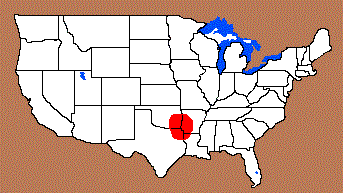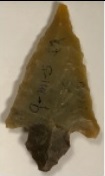Other Websites with Detailed Information:
Name Details:
Named By: Clarence Bloomfield Moore
Named For:
Date Identified: 1912
Type Site:
Haley site, Texas
Hayes Var. Turner
AKA: Crickett
(Collector Type)
Cluster:
Commonly Utilized Material:
Date:
Cultural Period:
1,200 - 600 B.P.
Mississippian - Late Prehistoric
Vandal Minimum to Medieval
Warm
Caddoan Culture
Glacial Period:
Culture:
Outline is Representative of Common Size and Shape:
Description of Physical Characteristics and Flaking Pattern:
This is a narrow
small to medium triangular expanding stem point with a flattened cross section. The blade is primarily excurvate, but may vary to recurvate flaring out at the
shoulders edge. Many examples have fine serrations along the blade. The shoulders may range from horizontal to having a downward
angle. The stem is expanding with a base that comes to a point which gives the stem a diamond appearance. This point
commonly has a high quality of workmanship and a random flaking pattern.
Size Measurements: Total Length -
40 to 50 mm, Stem Length - 8 to 10 mm, Blade Width - 15 to 20 mm, Neck Width -
5 to 7, Stem Width -
7 to 9
mm (***based on small sample size***)
Distribution:
Distribution Comments:
This point is primarily found in the Spiro region of Oklahoma and into Texas, Arkansas, and Louisiana.

Additional Comments:
Collector sources feel that this is a later variant of the Hayes type.
Size measurements are identical to Hayes, only difference is the offset tip. At the Craig Mound, Spiro Oklahoma, Brown (1966), types later Hayes types as Hayes Short type points which
followed the Alba and Hayes points.
Moore (2015) note that these points have also been referred to as Crickett
points.
Other points in this Cluster:
Point Validity: Collector Type
Moore was an avocational archaeologist who conducted excursion into Egypt, the Amazon,
Florida and Louisiana. He excavated several sites in Florida and published books on sites in Louisiana. This type was named in his book published in 1912, but this type is not currently used in
professional literature. This type is used by many collector type sources. This is considered a collector type.
.
Age Details:
Pictures Provided By:
References: (See Reference Page, Entry Number):
23, 30, 130, 182
Turner Projectile Point, Turner Arrowhead


